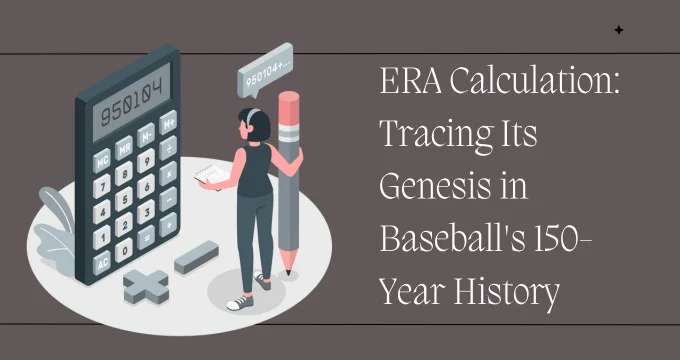The Earned Run Average (ERA), a pivotal statistic in the realm of baseball, holds a fascinating heritage steeped in the game’s rich history. This enigmatic metric, now a cornerstone in assessing a pitcher’s effectiveness, traces its roots back through 150 years of baseball evolution. The ERA computation, a central cog in the complex machinery of the sport, serves as an insightful lens into a player’s performance, dictating their standing in this beloved game.
The journey of ERA, from its inception to its present-day application, is an engaging tale of innovation and adaptation. It is a narrative that mirrors the game’s progression, evolving in tandem with baseball’s shifting strategies and styles. As we embark on an exploration of the ERA’s genesis and its profound impact on baseball’s 150-year narrative, we invite you on a riveting journey through time, where each pitch, each swing, and each inning chronicles a momentous saga of sports history.
ERA Calculation: Tracing Its Genesis in Baseball’s 150-Year History
The Beginning of Calculating ERA in Baseball
The inception of the Earned Run Average (ERA) in baseball is a testament to the dynamic evolution of the sport. Born out of necessity, it was devised to offer a more comprehensive perspective on a pitcher’s prowess, beyond the simple win-loss record. An era devoid of this crucial metric seems almost unfathomable in today’s baseball landscape, where each player’s value is intricately dissected with a bevy of statistical magnifying glasses, with ERA being one of the most significant.

The ERA made its debut in the late 19th century, a time when baseball was still in its nascent stages. The game then was a far cry from the highly strategic and meticulously analyzed sport we witness today. However, the need for a more nuanced measure of a pitcher’s performance was evident even then. The ERA offered a groundbreaking solution, measuring the average number of runs a pitcher allows per nine innings, giving teams an invaluable tool to assess each pitcher’s efficacy.
Since its introduction, the ERA has undergone several tweaks and refinements to better align with the evolving demands of the sport. What started as a rudimentary measure has morphed into a sophisticated and integral part of baseball metrics, holding a significant place in player evaluations and strategic decisions. As we delve deeper into the labyrinth of baseball’s statistics, the ERA stands tall as a shining beacon, guiding us through the sport’s captivating 150-year history.
ERA’s Evolution: A Historic Perspective
The Earned Run Average (ERA) has not only evolved but also shaped the strategy in baseball over time. Initially, ERA was a straightforward metric, using the formula: (Earned Runs/Innings Pitched) x 9. However, this simplicity belied its profound impact. ERA began to play a role in pitchers’ evaluations, influencing both player selection and game strategy. It shifted focus from sheer pitching power to a more nuanced understanding of a pitcher’s skill and consistency.
As baseball advanced into the 20th century, the ERA became increasingly instrumental. The sport saw a surge in strategic thinking, and the ERA was often the compass guiding these strategies. Teams started analyzing not just the raw ERA numbers, but also factoring in variables like home-field advantage, opponent strength, and individual player quirks. ERA was no longer just a number; it became a complex, multi-dimensional canvas capturing the essence of a pitcher’s performance.
Fast forward to the present day, and the ERA has metamorphosed into a deeply ingrained aspect of baseball. Modern baseball analytics use ERA variants such as FIP (Fielding Independent Pitching) and xFIP (Expected Fielding Independent Pitching) to evaluate a pitcher’s performance independent of the fielding defense, demonstrating how ERA has evolved along with the game’s strategic sophistication. A testament to this persistent evolution, ERA continues to remain a staple in the vibrant chronicle of baseball’s history, underscoring its enduring relevance and significance.
Unfolding the Story of Pitcher’s ERA Evaluation
The story of Earned Run Average analysis is akin to the unfolding narrative of a gripping book, filled with intriguing changes and unexpected turns. Initially, the calculation was straightforward, taking into account only earned runs and innings pitched. However, the formula was soon deemed inadequate to capture the true essence of a pitcher’s performance. The exciting quest to refine this crucial metric began, marking a significant chapter in the story of ERA.

As teams delved deeper into the strategic nuances of baseball, they sought to reflect diverse variables in the calculating era in baseball. They began including factors such as home-field advantage, strength of opponent, and weather conditions. This was a pivotal turn in the ERA narrative, transforming it from a simple number to a multi-faceted statistic that painted a comprehensive picture of a pitcher’s effectiveness on the field.
Fast forward to the present day, and the ERA stats have become a sophisticated model of analytical prowess. It has evolved with the introduction of advanced statistical measures, such as FIP and xFIP, which further refine a pitcher’s evaluation by eliminating the influence of defensive performance. This exciting evolution reaffirms ERA’s relevance in modern baseball, making it an ever-evolving protagonist in this intricate sport’s narrative. Thus, the Run prevention analysis, from its inception to its current refined state, continues to be a fascinating tale in the grand saga of baseball.
ERA: From Inception to Modern Day
The journey of the Earned Run Average (ERA) from inception to modern-day mirrors the riveting evolution of baseball itself. When ERA first graced the baseball scene in the late 19th century, it was a simplistic metric, designed to provide a more nuanced evaluation of a pitcher’s performance that transcended the basic win-loss record. This marked the dawn of a new era in baseball, one that embraced the profound potential of statistical analysis to illuminate the multifaceted brilliance of this beloved sport.
As the wheels of time turned, so did ERA evolve, adapting to the dynamic demands of an increasingly strategic game. The straightforward statistic transformed into a multi-dimensional tool, strategically incorporating various aspects such as home-field advantage, opponent strength, and weather conditions. This evolution of ERA added layers of complexity and depth to the game, making it an indispensable part of baseball’s strategic narrative.
In modern baseball, ERA stands tall as a testament to the game’s analytical sophistication. It is no longer a solitary metric but a crucial component of a vast statistical ecosystem, intertwined with advanced measures like FIP and xFIP. These adaptations have enhanced the ERA’s capabilities, making it a more precise reflection of a pitcher’s performance, devoid of fielding defense influence. This journey of ERA, from a rudimentary measure to a sophisticated analytical tool, is a captivating chapter in baseball’s enthralling saga, underscoring its enduring significance in this strategic game.
Understanding ERA’s Impact on Baseball
The Earned Run Average (ERA) has undeniably transformed the fabric of baseball, underlining the way teams strategize, players perform, and fans engage with the sport. Its influence on baseball is as multi-faceted as the statistic itself, serving as a lens through which the complexities of this beloved game come to life. The ERA is a cornerstone of player evaluation, shaping both team selections and on-field strategies. Its value extends beyond mere numbers, painting a comprehensive picture of a pitcher’s prowess and consistency on the field.

Moreover, the ERA has played a significant role in broadening our understanding of baseball. The statistic has evolved, incorporating various factors such as home-field advantage, opponent strength, and even weather conditions. These refinements have helped reveal the nuances of the game, unraveling layers of strategy and skill that remain hidden beneath the surface. The ERA’s evolution showcases baseball’s analytical progression, reflecting the sport’s transition from simple, face-value evaluations to intricate, data-driven analyses.
Finally, the ERA’s impact is deeply felt in the realm of fan engagement. It serves as a bridge connecting fans to the game’s strategic depth, giving them a more profound appreciation of the players’ performance. The ERA, in its modern, sophisticated form, allows fans to delve deeper into the game’s intricacies, fostering a richer, more comprehensive understanding of the sport they love. Therefore, the impact of ERA on baseball extends beyond the boundaries of the field, resonating with players, strategists, and fans alike, truly enhancing their baseball experience.
Conclusion
The roots of ERA in baseball are embedded in the sport’s early quest for quantifiable pitcher assessment. The tireless work of pioneering statisticians transformed this rudimentary measure into a sophisticated tool, refining its calculation to reflect the game’s evolving intricacies. The ERA’s journey, from a simple statistic to an influential metric, underscores baseball’s embrace of analytical depth, forever enriching our understanding and appreciation of this beloved sport. Its story serves as a reminder that every pitch, every run, and every game contributes to baseball’s dynamic, ever-evolving narrative.
Embark on a journey through the storied past of baseball’s ERA with ‘Exploring Baseball’s ERA: A Historical Perspective‘. This detailed guide offers a window into the origins and evolution of ERA, shedding light on its crucial role in baseball analytics.
FAQ’s
What sparked ERA’s inception and evolution purpose?
ERA’s origins stem from baseball’s need to quantify pitching effectiveness. Initially, it aimed to measure earned runs per game but evolved to incorporate advanced metrics. Over time, ERA became pivotal in evaluating a pitcher’s performance comprehensively, transcending its original purpose.
Trace ERA origins, and key influences in baseball’s early days.
ERA’s roots trace back to baseball’s early days, with statisticians like Henry Chadwick pioneering its conceptualization. Influenced by early game dynamics, ERA gradually transformed into a vital metric shaping pitcher evaluation in modern baseball.
How did the early ERA introduction impact pitcher evaluation?
The introduction of ERA as a statistic revolutionized how pitchers were assessed, shifting the focus from wins and losses to earned runs allowed. This transformed the perception of pitching performance, providing a more nuanced and accurate representation.
Role of early statisticians in ERA development?
Early baseball statisticians, including Allan Roth and Earnshaw Cook, played a pivotal role in formalizing pitch efficiency assessment methods. Their contributions laid the groundwork for the statistical standards that continue to influence how we evaluate pitchers today.
How did rule changes shape early ERA methods?
Changes in baseball rules and scoring criteria during its early years significantly impacted the refinement of Pitching efficiency assessment techniques. Adaptations to the game’s dynamics prompted adjustments in how earned runs were measured, shaping ERA’s role in assessing pitching performance.
How did historical equipment impact ERA accuracy?
The historical evolution of baseball equipment, particularly advancements in ball design and materials, has directly influenced the accuracy and relevance of ERA. Changes in equipment have posed challenges and opportunities, impacting how ERA reflects pitcher performance over time.

